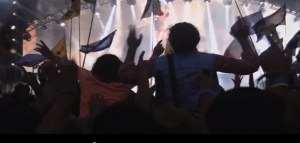Mandela Day: You are The Power of Change
Mandela Day is an international day in honour of Nelson Mandela,
celebrated annually on the 18th of July – Mandela’s Birthday.
It is a call to action for individuals – for people everywhere –
to take responsibility for changing the world into a better place,
one small step at a time, just as Mr Mandela did.
Following the success of Nelson Mandela’s 90th birthday celebrations in London’s Hyde Park in June 2008 and the 4664 concerts, it was decided that there could be nothing more fitting than to celebrate Mr Mandela’s birthday each year with a day dedicated to his life’s work and that of his charitable organisations, and to ensure his legacy continues forever.
The day was officially declared by the United Nations in November 2009. Mandela Day is not meant as a public holiday but is a global call to action that celebrates the idea that each individual has the ability to make an impact and the power to transform the world.
The Mandela Day campaign message is simple: Mr Mandela gave 67 years of his life fighting for the rights of humanity. All we are asking is that everyone gives 67 minutes of their time, whether it’s supporting your chosen charity or serving your local community.
Long Road to Freedom
On August 5th, 1962, an ordinary piece of road along the R103 about 3 kilometres outside Howick in KwaZulu-Natal took on extraordinary significance when armed apartheid police flagged down a car.
The man pretending to be the chauffeur had earned the nickname of the “Black Pimpernel” having evaded capture by the apartheid regime for 17 months. It was in this dramatic manner at this unassuming place that Nelson Mandela was finally captured and was to disappear from public view for the next 27 years.
Mandela had just paid a clandestine visit to ANC President Chief Albert Luthuli to report on his African Odyssey. His meeting was also to request support for an armed struggle, after having spent most of his adult life trying to find peaceful ways in which to end the injustice and suffering caused by the system of Apartheid in South Africa, without success.
50 years later on August 4th 2012, to mark the anniversary of the start of Nelson Mandela’s “long walk to freedom” a quietly powerful new sculpture was inaugurated and unveiled at this spot.
The sculpture is comprised of 50 steel column constructions, each between 6.5 and 9.5 meters tall, set into the landscape of the Natal Midlands. The posts are staggered and the portrait of Nelson Mandela only comes into correct focus when the posts line up at a position 35 meters from the sculpture (a reference to the fact that Mandela proved notoriously difficult for the authorities to find).
From this perspective the sculpture reads as a familiar photograph of Mandela, suggestive of his incarceration as one is aware it is comprised essentially of a series of steel bars, but seen from other angles the design splinters into a dynamic moment of fracture and release.
The artist Marco Cianfanelli comments on the deliberate structural paradox, that, “this represents the momentum gained in the struggle through the symbolic of Mandela’s capture. The 50 columns represent the 50 years since his capture, but they also suggest the idea of many making the whole; of solidarity. It points to an irony as the political act of Mandela’s incarceration cemented his status as an icon of struggle, which helped ferment the groundswell of resistance, solidarity and uprising, bringing about political change and democracy”.
http://www.mandela-children.org.uk/
Read MoreRolling Stones Headline at Glastonbury
home to Glastonbury Abbey, one of the most important abbeys in England.
It’s also a town which attracts thousands of people interested in New Age or Pagan beliefs largely because of the myths and legends related to Glastonbury Tor.
These include references to the Holy Grail, King Arthur and Joseph of Arimathea, with some Arthurian literature identifying it as the legendary Island of Avalon.
Glastonbury Festival of Contemporary Performing Arts
Internationally Glastonbury is best known as home to the most famous music festival in the world – The Glastonbury Festival of Contemporary Performing Arts which includes dance, comedy, theatre, circus, cabaret and other arts as well as contemporary music.
Festival organiser Michael Eavis is a local farmer who was inspired after seeing the open air Led Zeppelin concert at Bath Festival of Blues and Progressive Music, 1970 to host an open air festival on the the farm. 14 people invested everything they had to build the stage (many told them the idea would never catch on). The first festival was in 1970 – and the rest as they say, is history.
Rolling Stones Live at Glastonbury 2013
The Rolling Stones headlined the Pyramid Stage, playing to a crowd of over 170,000 (not bad for a group that has been around for 50 years).
Their gig started around 9.45 pm at the end of a beautifully sunny day in Somerset with the crowd waiting in electric anticipation for the most high profile act ever to perform at Glastonbury (having taken 43 years to get there) .
The Stones played a twenty song set including a version of “Factory Girl” which with specially adapted lyrics became “Glastonbury Girl”
“It was one of the greatest rock and roll sets I’ve ever seen in my life and I think one of the greatest rock and roll sets Glastonbury has ever seen”. “They really just rocked it. The band seemed almost as impressed as the crowd. I guess the audience makes the gig as much as the band.” Telegraph music critic Neil McCormick
Rolling Stones Glastonbury Song List:
‘Jumpin’ Jack Flash’
‘It’s Only Rock ‘N Roll (But I Like It)’
‘Paint It, Black’
‘Gimme Shelter’
‘Glastonbury Girl’
‘Wild Horses’
‘Doom And Gloom’
‘Can’t You Hear Me Knocking’
‘Honky Tonk Women’
‘You Got The Silver’ ‘Happy’
‘Miss You’
‘Midnight Rambler’
‘2000 Light Years From Home’
‘Sympathy For The Devil’
‘Start Me Up’
‘Tumbling Dice’
‘Brown Sugar’
‘You Can’t Always Get What You Want’ ‘
(I Can’t Get No) Satisfaction’
What the Posters Say
An interesting article by musician and writer, Anya Pearson looks at festivals as an annual yardstick of Britain’s musical talent. By taking the much publicised Festival Posters and editing out all acts represented on the posters that do not include at least one female musician, she turns them into a barometer of gender equality in 21st Century Britain. “As a female musician currently in two mixed-gender bands, I have always been painfully aware of my minority status in the music scene.” she says.
Glastonbury 2013 Poster showing music acts appearing at the festival

Glastonbury 2013 Poster – showing only acts that include
at least one female musician (34%).

Glastonbury was not the worst offender for failing to represent female musicians, probably thanks partly to co-organiser of the event, Emily Eavis, but its poster still only had 34% of the acts that included female musicians.
Bestival 2013 Poster showing music acts appearing at the festival

Bestival 2013 Poster showing only acts that include
at least one female (21%)

Reading and Leeds 2013: Poster showing music acts appearing at the festivals

Reading and Leeds 2013: Poster showing only music acts appearing at
the festivals which include at least one female (17%)

Pearson concludes:
“Still, festivals alone are not to blame: promoters, managers and record labels all play their part. As a society we are less encouraging of girls who aspire to headline Glastonbury. I was lucky. My mother is a musician who started out in the 70s and always told me my XX chromosome was no barrier to making music.
That said, there are lots of brilliant female musicians out there – as Yoko Ono’s Meltdown at the Southbank Centre proved. Women aren’t passive consumers of popular culture – we just often lack a creative platform to showcase what we can do.”
http://www.glastonburyfestivals.co.uk/
http://womensliberationmusicarchive.co.uk/
http://www.southbankcentre.co.uk/whatson/festivals-series/yoko-onos-meltdown/
http://www.guardian.co.uk/commentisfree/2013/jun/26/glastonbury-festival-few-women-artists
Read More


